The D major scale in Guitar is a scale that is quite important to learn since it is often used in many songs and compositions. The key of D major is considered to be of a happy mood as is mostly the case with every other major scale. Two of the D major scale notes is shifted up by one semi-tone. These notes are C# and F#. So, the D major key has two sharps and therefore this scale can be called a two-sharp scale. In this blog you will learn different notes in D major scale, it’s positions and how to play all these different D major scale positions on your guitar.
Songs in the key of D Major
There are a variety of songs created in the D major scale. This scale is perfect for guitarists who want to jam along with songs created in the key of D major because there’s so many of them. Some songs in the D major key that come to mind are One Last Breath (Creed), Everybody Hurts (R.E.M), Open Your Eyes (Alter Bridge), Crazy Little Thing Called Love (Queen), Drifting (Andy McKee), Thinking Out Loud (Ed Sheeran), All My Days (Alexi Murdock), Love Story (Taylor Swift), Dear Prudence (Beatles) and Summer Of ’69 (Bryan Adams).
Playing some of these lovely songs require prior knowledge in the D major scale notes. These are formed using the concept of intervals (tones and semi-tones).
Notes in the scale of D Major
To figure out all the notes in the major scale D, it’s better to play them all on one string – the 4th string which when played open is the root note D. Here’s a fret-board diagram that shows all the D major scale notes if played from the open D string all the way to the 12th fret.

So, to play this scale in guitar, start by playing the 4th string open. Then play the next note which will be two frets higher (a tone). So, press the 2nd fret with the fretting hand (that holds down the strings on the fret-board) and pluck the same string. The next note (F#) is also a tone apart. So play F# on the 4th fret.
The note after that is only a semi-tone away. So play G on the next immediate fret. The next three notes A, B and C# are all a tone apart as well. So go ahead and play these notes on the 7th, 9th and 11th frets. The last note is only a tone apart. So play the last highest sounding note (D) on the 12th fret.
Given below is the tablatures for the D major scale in guitar.

The italic numbers represent the finger numbers of the fretting hand. This is what the numbers mean:
1 – pointer/index finger 2 – middle finger
3 – ring finger 4 – little finger
You may have observed that both the 3rd and 4th notes and the 7th and 8th notes of the D major scale in guitar have the same interval – a semi-tone. This is true for all major scales D and is crucial to remember this anytime you try and figure out the notes of a major scale.
Playing the major scale D on guitar in this way is quite chaotic and hard to control. So, there are different ways to play all the notes in guitar which is categorized as positions. Each D major scale positions on guitar restricts all the notes to a few number of frets. This makes it easier to play them. As the positions get higher, the notes ascend higher in pitch as well.
Here mentioned all position of the D major scale:
D Major Scale Guitar all Positions
1. D Major Scale Open position
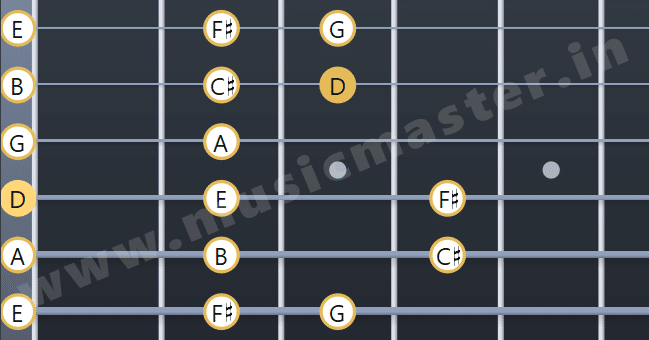
As the name suggests, the open D major scale position on guitar refers to the fact that there are notes played on open strings. The farthest fret to play in this position is the 4th fret on the 5th (A) and 4th (D) strings. Since, most of the notes on each string after the open notes are on the 2nd, 3rd, and 4th strings, the middle, ring and little fingers are best suited to hold down these notes on these frets. Tablatures below also show finger numbers in italics as a guide to play this scale shape in the best way possible.

2. D Major Scale Second Position
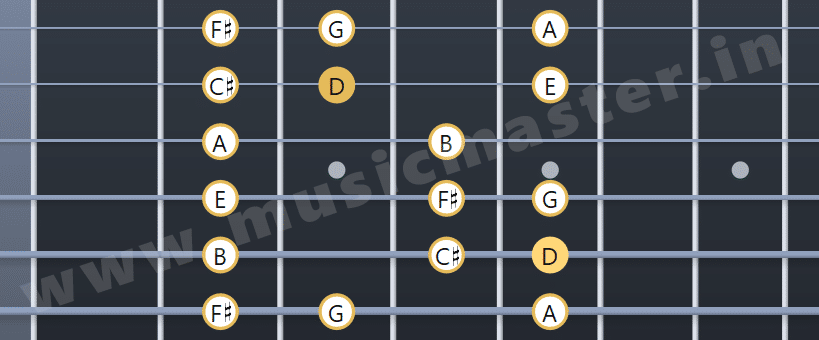
The notes in this D major scale position on guitar starts on the 2nd fret. So, move your fretting hand up by a fret in such a way that the pointer, middle, ring and little fingers can press down the 2nd, 3rd, 4th and 5th frets respectively. All four fingers of the fretting hand are used to play the notes in the second position of the major scale D. It cam be quite tricky at first. But it gets easier once you get used to it. Follow the tablatures below.

3. D Major Scale Third Position
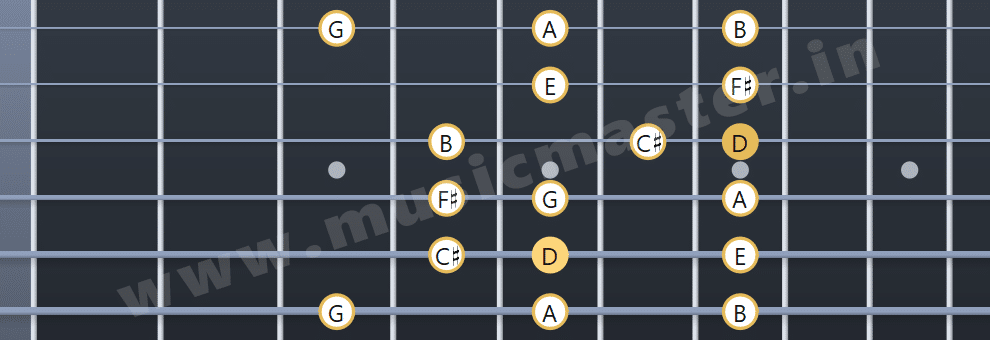
In this D major scale guitar position, we will be playing the notes across five frets. Just for the notes on the 6th and 1st strings, the pointer, middle and little fingers are needed to hold down the 3rd, 5th, and 7th frets. This may involve a lot of stretching by the fretting hand. So, try not to strain the hand too much. Alternatively, try to pivot the thumb behind the 5th fret on the neck and rock the fretting the hand to and fret to access the 3rd and 7th frets, which are the farthest from each other. Tablatures for this position with finger numbers are provided below.
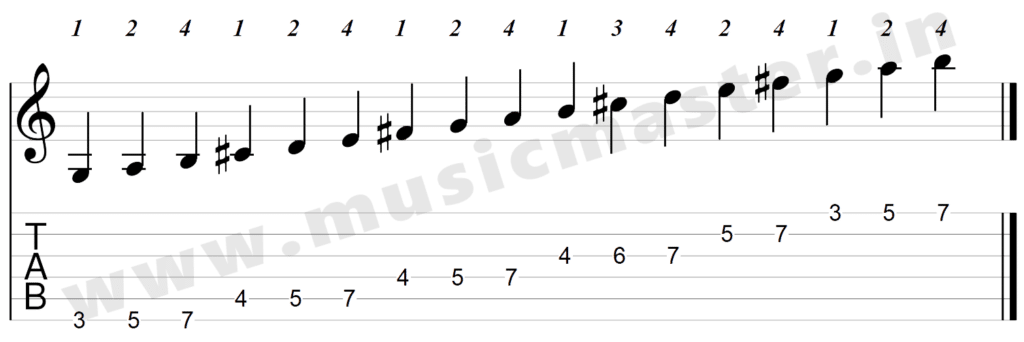
4. D Major Scale Seventh Position

To play the notes on the seventh position of the D major scale, move the fretting hand up by a few frets so that the pointer can start playing the first note on the 6th string on the 7th fret. When you come to the 3rd string, move the fretting hand down by a fret so that the pointer, middle and little fingers can play the 6th, 7th and 9th frets respectively. For the notes on the 2nd and 1st strings, the fretting hand can move up again to the original place it was for the notes on the 6th, 5th and 4th strings. The tablatures below have finger numbers in italics and will guide you through this scale shape.

5. D Major Scale Ninth Position

Pitch-wise, the notes in the ninth position of the D major scale are quite the same as the notes previously played in the seventh position. The notes in this scale shape are conveniently confined to the 9th, 10th, 11th and 12th frets. This makes it easier for the fretting hand to hold down these notes once you move it close to the 9th fret so that the pointer, middle, ring and little fingers play the notes on the 9th, 10th, 11th, and 12th frets respectively.

6. D Major Scale Tenth Position

This is final scale position in the D major scale. It seems to follow the three-notes-per-string pattern used in a lot of guitar solos. The notes in this scale move across 6 frets, all the way to the 15th fret. The lowest note is on the 6th string at the 10th fret. You may use the ‘pivot’ technique mentioned earlier (in the third position of the D major scale) to play the notes on the 6th and 5th strings. This way, you don’t need to reposition your fretting hand to play the three notes on the 4th and 3rd strings. But, you need to reposition your fretting hand to the 12th fret to play the three notes on the 2nd and 1st strings. Check out the tablatures below hinted with finger numbers in italics.

Okay, now you know the different D major scale positions on guitar. But, did you know that you can play the notes in these scale shapes in reverse? Start from the last note on the 1st string and work your way backwards until you reach the first note on the 6th string. If you can do that successfully, play every scale shape both forwards and backwards playing the last note once before you play the rest of the notes again in reverse order. This way, you have succeeded in playing the scale both in ascending and descending order pitch-wise. This is a useful technique to truly master the D major scale and helps in learning songs in the D major key more effectively.
From the notes discussed above in the scale positions, it is possible to come up with the chord of the D major key – the D major chord. Here’s how:
D Major Chord

The D major chord is one of the most widely used open D major scale guitar chords on the guitar. The notes in the D major chord is quite easily created using the concept of major triads. A major triad is created using the 1st, 3rd and 5th notes of the major scale.
If you look back at the notes of the major scale D, you can see that the 1st note is the root note D, the 3rd note is F# and the 5th note is A. These are the notes required to play the D major chord. Here’s the easiest version of the D major triad played on the top three strings.

You need to press the pointer at the 2nd fret on the 3rd string, ring finger at the 3rd fret of the 2nd string and pull the middle finger back to press the 2nd fret on the 1st string. Once you add the open 4th string, you have the full D major chord in the open position like the chord diagram below.

So, to play along with your favourite songs in the D major key, you need to know other chords that go along with the D major chord. Here’s the relative D major scale chords.
Relative D Major Scale Guitar Chords

1. E Minor Chord
The E minor triad consists of the notes E, B and D. E minor chord also one of the most commonly used open chords that sounds good with other chords. Hold the 5th and 4th strings with your middle and ring fingers at the 2nd fret. Leave the other strings open. Due to the fact that it is so easy to play, it can be used to train the picking hand to master the different strumming patterns.
2. F# Minor Chord
The F# minor is often played as a barre chord. It’s lowest sounding root note is found on the 6th string at the 2nd fret. It’s minor triad includes the notes F# A and C#. To hold this chord shape, begin by placing the pointer at the 2nd fret across all the strings. After that, place your ring and little fingers at the 4th fret on the 5th and 4th strings. The chord shape used for this chord is often transposed down the neck of the guitar and used for other minor chords.


3. G Major Chord
The G major chord is one of every guitarist’s favourite chord. The 1st, 3rd, and 5th notes in the G major triad are G, B and D respectively. Press the 6th and 5th strings at the 3rd and 2nd frets of the guitar using your middle and index fingers. Push your ring finger back to hold the 1st string at the 3rd fret. Leave the strings in the middle open. This open chord is also quite popularly played in many songs, usually with D major, A major and E minor chord combinations.
4. A Major Chord
Here’s another frequently played beginner chord – the A major chord. The root, 3rd and the 5th notes (A, C# and E) are the three different notes that make the A major triad. The 5th string with the root note ‘A’ is left open. The 4th, 3rd and 2nd strings are held at the 2nd fret using the index, middle and ring fingers. The 1st string is also left open. In almost any song in the D major key, you’ll probably hear the A major chord somewhere in the chord transitions.
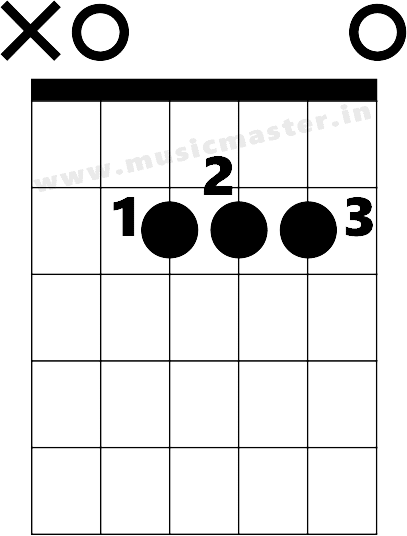

5. B Minor Chord
The relative minor of the D major key is B minor. The B minor triad consists of the notes B, D and F#. Relatively, the B minor chord is one of the easier barre chords to learn on the guitar. Press all the strings with just your pointer at the 2nd fret. Hold the 2nd string at the 3rd fret. Finally, hold the 4th and 3rd strings at the 4th fret with your ring and little fingers. The chord shape used for this chord can be transposed and used for other minor chord inversions as well.
6. C# Diminished Chord
The last relative chord in the D major key is the C# diminished. This chord is represented with a ° symbol next to it. Start by using your little finger to hold the root note (C#) at the 4th fret of the 5th string. Next, press the 4th string with your index finger at the 2nd fret. Leave the 3rd string open. Finally, press down the 2nd string with your index finger. The C# diminished is quite an odd sounding chord especially when the ♭3rd note (E) is played with the root note (C#) and the ♭5th (G).

Well, those are some of the relative d major scale guitar chords Initially transitioning from one chord shape to the next will be challenging. Just playing one chord alone might be very difficult at first. You need to make sure that the fingers holding down the strings in any chord doesn’t accidentally touch an unwanted or open string resulting in a muted or buzzed sound.
Once you’re able to play the chords clearly, try transitioning from one chord to another and then play along with the metronome at a really basic and slow tempo, like 60 BPM. Eventually, as your confidence builds up, practice with a faster tempo. Don’t cut off the previous chord when trying to reposition your fingers to hold the next chord shape. Try to sustain each chord for the duration of the whole beat.
































